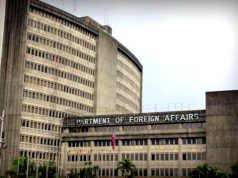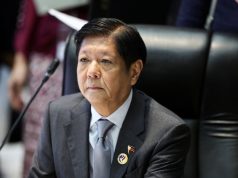
BEIJING/TAIPEI— China’s latest military drills near Taiwan show it is serious about being able to cut off the democratically ruled island in a conflict, analysts said, as Beijing said its aircraft carriers could “shatter” defenses from the east.
Although the three-day exercises, which ended Monday, were not as intense as those that unfolded in August 2022 in protest of then-U.S. House Speaker Nancy Pelosi’s visit to Taipei, China used them to show off its capabilities in the air and sea – both of which it would need to control if it attempted a blockade.
Here are the key takeaways from the drills.
1) Carrier Operations
Many analysts noted the jets flying off the Shandong aircraft carrier, which took up position east of Taiwan, about 230 kilometers (143 miles) south of Japan’s Miyajima island.
The carrier’s presence there meant China “can shatter Taiwan’s so-called eastern shield”, Zhao Xiaozhuo, a senior colonel and researcher with People’s Liberation Army Academy of Military Sciences, told state news agency Xinhua.
Beijing could not operate carriers with impunity in that area during a conflict, analysts said, especially if nations friendly to Taiwan were involved, but added that Taiwan would struggle to deal with such a threat on its own.
Chieh Chung, a military researcher at the Taipei-based National Policy Foundation think tank, said in the event of a attack, Taiwan would likely withdraw its military assets from the west to bases in the east, shielded by the island’s high mountains and equipped with underground tunnels.
But an unfettered, more coordinated attack from the east would mean “the whole situation will turn very unfavorable,” he said.
2) Deterring foreign help
Videos of the exercise released by the People’s Liberation Army’s (PLA) Eastern Theatre Command showed its vessels and planes came within 24 nautical miles of Taiwan on all sides of the island, which Beijing claims as its own.
The aim of the drills was to show that they could encircle Taiwan in a blockade and deter foreign powers from intervening, Zhao said.
That would be crucial if a conflict erupted.
“An invasion by China would require the PLA to carry out joint counter-intervention operations against the United States, which Beijing believes will almost certainly intervene, and now possibly with allies like Australia and Japan, maybe even the Philippines,” said Derek Grossman, a senior defense analyst at RAND Corporation.
Although the United States has long followed a policy of “strategic ambiguity” on whether it would intervene militarily to protect Taiwan, U.S. President Joe Biden has said he would be willing to use force to defend Taiwan.
3) Precision Targeting
The PLA also said it carried out virtual simulations showing how its forces could execute targeted missile attacks on Taiwan.
Zhang Chi, a senior colonel and assistant professor with National Defense University, told Xinhua that the simulated precision attacks meant that China could eliminate Taiwanese leaders in a “Zhanshou” operation, which translates as “beheaded”. In Western military parlance, such attacks are referred to as “decapitation strikes”.
The drills were a response to a recent meeting in California between U.S. House Speaker Kevin McCarthy and Taiwan’s president, Tsai Ing-wen, whom China views as a separatist.
4) Japan on alert
China’s focus on the seas east of Taiwan are particularly worrisome for Japan, said Bonji Ohara, senior fellow at the Sasakawa Peace Foundation and a former military attache at Japan’s embassy in China.
“Japan’s southwestern islands could be included in the blockade area,” Ohara said. “The question of how to break through there has once again been posed to Japan. It also reminded Japan that the blockade could cut off the sea lanes that carry crude oil and food to the country, which would be a major blow to the Japanese economy.”
Japan’s military said in a briefing on Tuesday that it was assessing China’s maneuvers around Taiwan, but described them as “without question, serious training”.
—Reporting by Yew Lun Tian and Laurie Chen in Beijing; Yimou Lee in Taipei; Tim Kelly and Nobuhiro Kubo in Tokyo; Editing by Gerry Doyle









